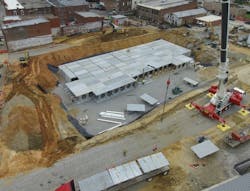StormWater Management System Reduces Flooding & Improves Storm Water Quality
About the author:
StormTrap, www.stormtrap.com, 877.867.6872
A large underground storm water management system was recently installed in downtown Wilson, North Carolina, to mitigate recurrent flooding issues in the area. During heavy rain events, the old and undersized storm water infrastructure could not hold the excess water, which would then back up and flow out of the local catch basins. The main goal of this project was to alleviate pressure in the current system and also improve the quality of storm water leaving the site.
Project Considerations
The cost to upgrade the current system was high due to the number of new pipes and new structures needed and other utility conflicts. StormTrap was contacted by the city of Wilson Stormwater Compliance Department and Bartlett Engineering & Surveying to identify a cost-effective solution to the problem versus replacing the existing system.
Through the project consultant’s investigation, it was determined that the Whirligig Station parking lot was the best location for a new storm water management system. Working closely with the engineering team, an underground sand-filter system was designed for the site. The system was selected due to its capacity to store a large quantity of water in a small footprint, its treatment feature, the long-term design service life of concrete and the ability to make the basin watertight.
The Construction Challenges
The project was not without obstacles. The main challenge was the compressed timeline to complete the project. Everything had to be finalized by the middle of July 2020 due to other development deadlines and start dates tied to the project.
“StormTrap made this possible by accommodating the expedited timeline and ensuring all the precast modular pieces were manufactured and delivered by the first week of June to guarantee the construction deadline was met,” said Noah Parsons, Wilson Stormwater Compliance specialist.
The other challenges that the team faced were excessive rainfall during construction, poor soil conditions and high groundwater.
“In this area, the seasonal water table is about 6 feet below the surface, and there are around 9-acres of impervious drainage that need to be captured. Based on the flows and the water table, we needed a product that was structural as well as watertight,” Parsons said.
During installation, the team discovered that the entire system needed to be lowered 6 inches due to an elevation issue with the existing storm drain system. The issue was quickly resolved.
“StormTrap was contacted, and we had an answer promptly. We couldn’t have asked for better cooperation and partnership. They had a representative on-site working with our contractor to ensure proper installation,” said Bill Bass, Wilson public works director.
The Design of the System
Considering the spatial restraints in the parking lot area, an 8-foot-4-inch DoubleTrap basin, built with 298 precast modular pieces, was the perfect fit. The system features three main areas: a sedimentation chamber, a sand filter and a detention area. Storm water from Goldsboro Street enters the system through a 36-inch pipe to the sedimentation chamber. An overflow weir with (18) 2-foot-wide openings separates the sedimentation area from the sand filter. The detention system is wrapped around the sand filter chamber. Pretreated storm water is released from the detention area at a controlled rate, through an 18-inch outlet control structure.
“The benefit of StormTrap does not only reduce the potential for localized flooding but also the benefit of reduced flows downstream,” Bass said.
The system capacity is approximately 116,000 cubic feet of storm water and complies with the North Carolina Department of Environmental Quality (NCDEQ) storm water design manual criteria requirements for volume control and water treatment.
"The project is also one part of a comprehensive plan to improve the Hominy Creek, which the U.S. EPA has designated an impaired stream," Parsons said.
The entire project was efficiently completed within the timeline projected for seven weeks. The storm water management system was installed in six days by Fred Smith Co.
“StormTrap was a great partner to the city and our contractor. They worked to help deliver a very successful project,” Bass said.







